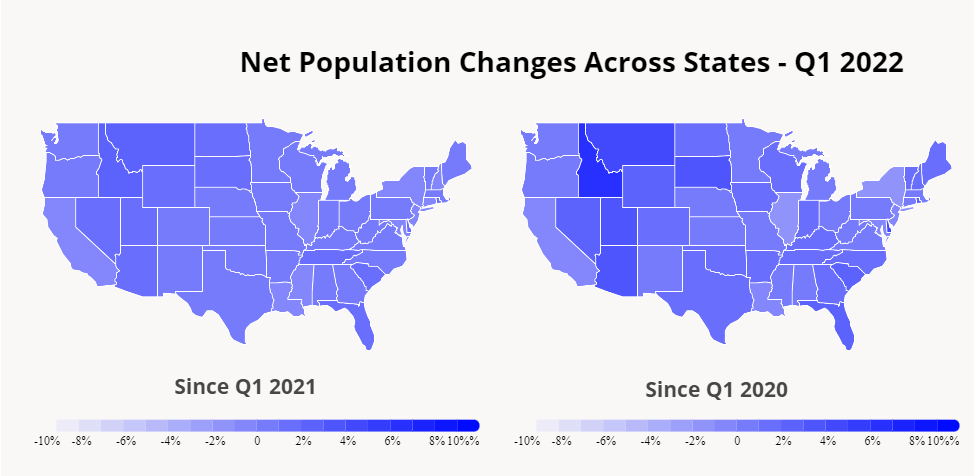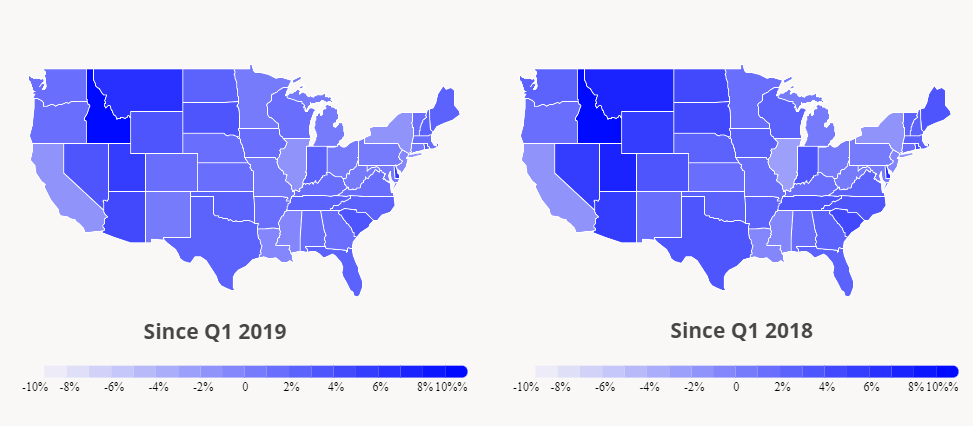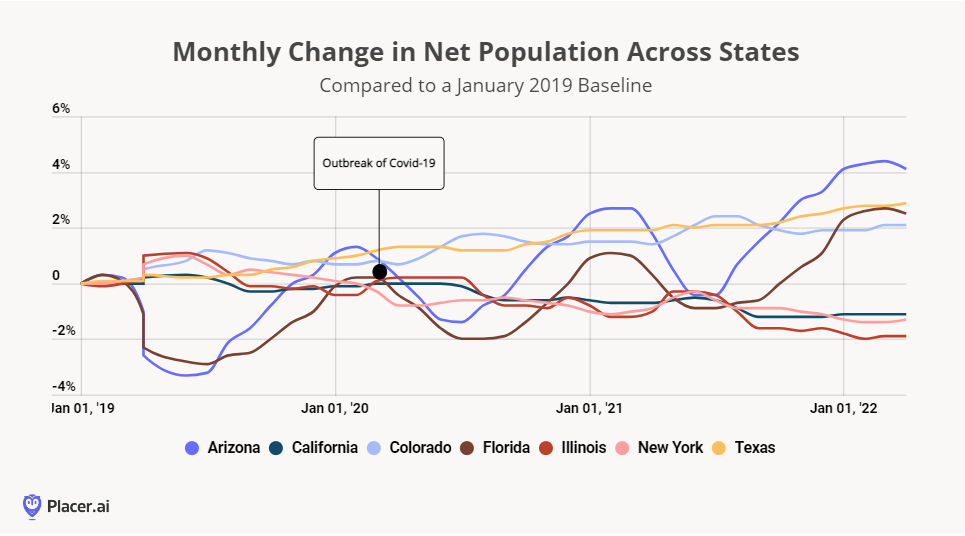
Our latest white paper dives into domestic migration trends over the past two years in the United States. While many assumed that there would be a mass exodus from cities, the foot traffic data tells a slightly different story. While some people made big moves, most stayed in place. Others moved, but stayed close to their region of origin. And many of those who did relocate across state lines chose areas whose population had already been trending up pre-pandemic. Below is a taste of our findings. For the full report, click here.
COVID Didn’t Upend Migration Patterns
The beginning of the pandemic saw many think-pieces predicting that the areas in which Americans would choose to live would forever be changed. But taking a wider view and looking at the population shifts since 2018 shows that – with some exceptions – much of the migration over COVID followed trends that had already been taking place.
The change in net population across states between Q1 2021 and Q1 2022 (shown in the top left map below) stayed between the range of -0.9% (in Illinois and New Jersey) and 2.3% (in Idaho). Even when we compared the population in Q1 2022 to Q1 2019 and Q1 2018, the changes still remained relatively small in most states. And the states that did see more substantial population growth in the past three to four years are states with a more rural and sparse population like Idaho (12.2% population growth since Q1 2018) and Montana (7.7% population growth since Q1 2018) where populations were small to begin with – so even a slight increase is likely to have a dramatic impact on the population rates.
But while the pandemic did not necessarily change the direction of internal migration, COVID may have accelerated some trends already in place. Several states with large urban populations saw their populations shrink somewhat, with New York, Illinois, and California all seeing gradual declines in population of 1.1%, 2.2%, and 1.1%, respectively, since Q1 2018. And some cities with dense office areas also saw declines in population as remote work became the norm.


But whether people relocated because of COVID or because of factors and trends already in place pre-pandemic, the data does show that a small, but significant, share of the population have moved across state lines since 2018. And since moving out of state is both expensive and labor intensive, families and individuals with the resources available make up a very specific demographic that can have an outsized impact on foot traffic to dining, retail, recreation, health, and cultural venues.
The Strong Got Stronger
Our data, illustrated in the graph below, shows that states that were already attracting new residents throughout 2019 continued to do so during the pandemic. Florida and Arizona, two states known for typical winter population surges as “snowbirds” arrive, have seen their winter population increase every year since 2019. The populations of Texas and Colorado have also been trending up for years.
But the pandemic also caused some declines in states with pre-pandemic stagnant populations such as New York, Illinois, and California. So while COVID did not reverse any growth trend, not all the relocation patterns seen over the past two years started before 2020. Still, it’s important to note that the population declines in previously stagnant states were generally smaller than the equivalent increases in the growing states. This means that the trends that were already in place on the eve of the COVID outbreak generally had a larger impact on population patterns.
At the same time, a positive or negative 2% to 4% change in statewide population over three years may seem small, but it is still significant. And the chart below indicates that not only were some of these trends in place pre-COVID – the trends continued in 2021 even after many of the pandemic-related restrictions eased up. Arizona, Texas, Florida, and Colorado saw an increase in population between January 2021 and January 2022, while California, New York, and Illinois saw their populations decrease slightly. Should these shifts continue, the impact on everything from housing supply to city planning to retail performance could be dramatic.

To learn more about the data behind this article and what Placer has to offer, visit https://www.placer.ai/.







Sign up to receive our stories in your inbox.
Data is changing the speed of business. Investors, Corporations, and Governments are buying new, differentiated data to gain visibility make better decisions. Don't fall behind. Let us help.













Sign up to receive our stories in your inbox.
Data is changing the speed of business. Investors, Corporations, and Governments are buying new, differentiated data to gain visibility make better decisions. Don't fall behind. Let us help.





